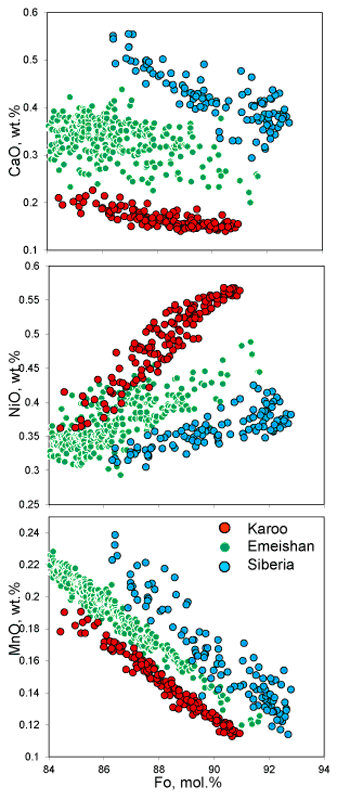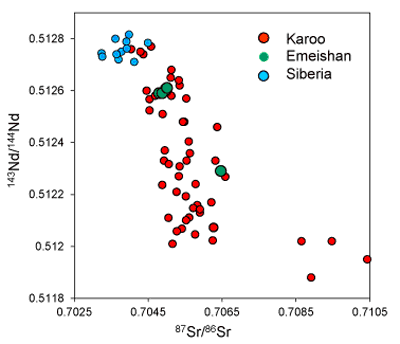 |
Multiple mantle sources of continental magmatism |
V.S. Kamenetsky1, R. Maas2, M.B. Kamenetsky1, G.M. Yaxley3, K. Ehrig4, G.F. Zellmer5, I.N. Bindeman6, A.V. Sobolev7, D.V. Kuzmin8, A.V. Ivanov9, J. Woodhead2 & J.G. Schilling10
1School of Physical Sciences, University of Tasmania, Hobart, TAS 7001, Australia; dima.kamenetsky@utas.edu.au ; Maya.Kamenetsky@utas.edu.au
2School of Earth Sciences, University of Melbourne, Parkville, VIC 3010, Australia; maasr@unimelb.edu.au
3Research School of Earth Sciences, The Australian National University, Canberra, ACT 0200, Australia; greg.yaxley@anu.edu.au
4BHP Billiton Olympic Dam, Adelaide, SA 5000, Australia;Kathy.J.Ehrig@bhpbilliton.com
5Volcanic Risk Solutions, IAE, Massey University, Palmerston North 4442, New Zealand; G.F.Zellmer@massey.ac.nz
6Department of Geological Sciences, 1272, University of Oregon, Eugene, OR, United States; bindeman@uoregon.edu
7Université Grenoble Alpes, Institute Science de la Terre, CNRS, F-38041 Grenoble, France;
8VS Sobolev Institute of Geology and Mineralogy SB RAS, Novosibirsk 630090, Russia; kuzmin@igm.nsc.ru
9Institute of the Earth's Crust, Siberian Branch of the Russian Academy of Sciences, 664033 Irkutsk, Russia; aivanov@crust.irk.ru
10University of Rhode Island, Narragansett, RI, United States; jgs@gso.uri.edu
This webpage is a summary of Kamenetsky, Vadim S., Roland Maas, Maya B. Kamenetsky, Gregory M. Yaxley, Kathy Ehrig, Georg F. Zellmer, Ilya N. Bindeman, Alexander V. Sobolev, Dmitry V. Kuzmin, Alexei V. Ivanov, Jon Woodhead, Jean-Guy Schilling, Multiple mantle sources of continental magmatism: Insights from “high-Ti” picrites of Karoo and other large igneous provinces Chemical Geology, 455, 22-31, 2017.
Continental Large Igneous Provinces (LIPs) are represented by exceptionally large volumes of magma (in excess of 106 km3), erupted over relatively short timescales (<5 Ma). Formation of LIPs requires extraordinary rates of melt supply somewhere below the surface. Where and how exactly the magmas supplying LIPs are produced has been and still is a subject of rigorous debates (e.g., http://www.mantleplumes.org/; http://www.largeigneousprovinces.org/).
The advocated principal magmatic sources of LIPs, lower mantle and subcontinental lithospheric mantle (SCLM), represent two end-members in the spectrum of possible contributors to geochemical diversity recorded in LIP magmas. In addition to geochemical end-members, other mantle (e.g., asthenosphere) and crustal sources have been also considered when required to design “plausible” petrogenetic models. The lower mantle source, loosely defined as a “deep mantle plume”, is heterogeneous (e.g., “heads” and “tails”). Similarly, the SCLM is intrinsically stratified and heterogeneous vertically and laterally. Both these end-member sources for LIP magmas are considered to be supplemented by the asthenospheric mantle, either as a contaminant to “deep mantle plume” material on its upward passage, or as the source of heat and melt, causing modifications and ultimate melting in the overlying SCLM. LIP genetic models are further complicated by adding the continental crust that is unavoidable by all mantle-derived magmas on their way to the surface in continental areas.
Understanding the mantle sources of LIPs critically depends on deciphering the compositions of primary melts and related physical factors such as temperature, pressure and degree of melting. Only with these parameters in hand can realistic constraints on the parental mantle source be made. Unfortunately, the majority of LIP rocks do not fit general criteria for primary/primitive melts (i.e. they feature <8 wt% MgO and the absence of high-Fo olivine phenocrysts).
The picrites we studied from the ~180 Ma Karoo (Letaba Formation), ~260 Ma Emeishan (Yongsheng, SW China) and ~250 Ma Siberian (Maimecha-Kotuy, N Siberia) LIPs are indistinguishable in having high-Ti compositions, being enriched in most incompatible trace elements (e.g., high La/Sm), but depleted in heavy rare-earth elements (i.e. the so-called “garnet signature”). They are also alike in having very primitive olivine (85-93 mol% Fo) and high-Mg# Cr-spinel with high-Ti and low-Al compositions. If only the above geochemical and mineralogical characteristics are taken into account, the rocks studied from the three LIPs may be considered to represent nearly identical parental melts and mantle sources.
However, a number of other features in these three suites either overlap only partially, or diverge. Some of these are:
-
Olivine trace-element signatures for a given Fo content are distinctly different (Figure 1). The Mn/Fe and Ni/MgO ratios in the Siberian olivines indicate a mantle peridotite source ( Sobolev et al., 2009) with very low “hybrid pyroxenite” (<10%, Sobolev et al., 2011), whereas this is much more prominent in the compositions of melts that crystallized olivine in picrites from Emeishan (~60%, Kamenetsky et al., 2012) and Karoo (>80%);
-
The δ18O compositions of the Emeishan and Siberian olivines are broadly similar (4.92 and 5.08 ‰, respectively) and (peridotite) mantle-like, but distinctly lighter than Karoo olivine δ18O compositions. This was independently accounted for by a significant eclogite component in the mantle source (Harris et al., 2015);
-
The Sr and Nd isotope ratios recorded in the high-Ti olivine-phyric suites from different cratons are markedly different (Figure 2), as they span the range from values more typical of a depleted source (Siberia), to those similar to “bulk Earth” (Emeishan), to EM-1 mantle (Karoo).

Figure 1: Compositions of primitive olivine phenocrysts in high-Ti rocks from the Phanerozoic Large Igneous Provinces Karoo, S. Africa, Emeishan, SW China and N Siberia, Russia.
A comparison of enriched picritic rocks with highly magnesian olivine from three major continental LIPs thus demonstrates that their primary melts cannot be attributed to a common mantle source and similar melting conditions. We also show that conclusions about compositions and evolutionary pathways of mantle sources based on overlapping distributions of some chemical features can be misleading. In other words, similarities and differences between rock/mineral compositions do not necessarily correlate with similarities and differences in their mantle source compositions or with the physical conditions of melting and melt extraction.

Figure 2: Sr and Nd isotope compositions of high-Ti rocks from the Phanerozoic Large Igneous Provinces Karoo, S. Africa, Emeishan, SW China and N Siberia, Russia..
Our paper is not a reconciliation of different data and models to build a coherent picture of LIP magmatism. Instead, we demonstrate that when it comes to recognizing primary melt compositions and interpreting their respective mantle sources, our understanding of LIP magmatism is crippled by a “human factor”. This is illustrated by the story “The blind men and the elephant”. This relates to our omission to consider all the types of rocks, even in a single LIP, to extract all possible mineralogical and chemical data. Inferences regarding mantle source composition, extent of melting, and depth of melt segregation must be based on both whole-rock compositions and robust data on the earliest liquidus assemblage (i.e. olivine, Cr-spinel ± pyroxene). Phenocryst populations may vary within a given locality as a result of diverse parental/primary melts involved in single or multiple episodes of magmatism. Our observations suggest that compositional heterogeneity in continental flood basalt provinces may be related to contributions from multiple superposed mantle sources with different long-lived melting histories on multiple spatial and temporal scales.
The main conclusion of our study is that the lack of a unifying model for LIPs is a consequence of the lithological and geochemical complexity of erupted magmas on local (e.g., a single outcrop) and regional (individual LIPs) scales. Attempting to use one or several overlapping chemical characteristics to make a unifed model of LIP magmatism on a planetary scale is futile. Such a conclusion may sound negative but in truth it is a call for reconciliation between still-conflicting research approaches and the forward models they produce.
References
-
Harris, C., le Roux, P., Cochrane, R., Martin, L., Duncan, A.R., Marsh, J.S., le Roex, A.P., Class, C., 2015. The oxygen isotope composition of Karoo and Etendeka picrites: High δ18O mantle or crustal contamination? Contrib. Mineral. Petrol., 170: art. 8.
-
Kamenetsky, V.S., Chung, S.-L., Kamenetsky, M.B., Kuzmin, D.V., 2012. Picrites from the Emeishan Large Igneous Province, SW China: A compositional continuum in primitive magmas and respective mantle sources. J. Petrol., 53: 2095-2113.
-
Sobolev, A.V.,
S.V. Sobolev, D.V. Kuzmin, K.N. Malitch, A.G. Petrunin,
Siberian meimechites: origin and relation to flood
basalts and kimberlites, Russian
Geology and Geophysics, 50,
999–1033,
2009.
-
Sobolev,
Stephan V., Alexander V. Sobolev, Dmitry V.
Kuzmin, Nadezhda A. Krivolutskaya, Alexey G.
Petrunin, Nicholas T. Arndt, Viktor A. Radko & Yuri
R. Vasiliev, Linking mantle plumes, large igneous
provinces and environmental catastrophes, Nature, 477,
312–316, 2011.
last updated 21st
December, 2017 |
